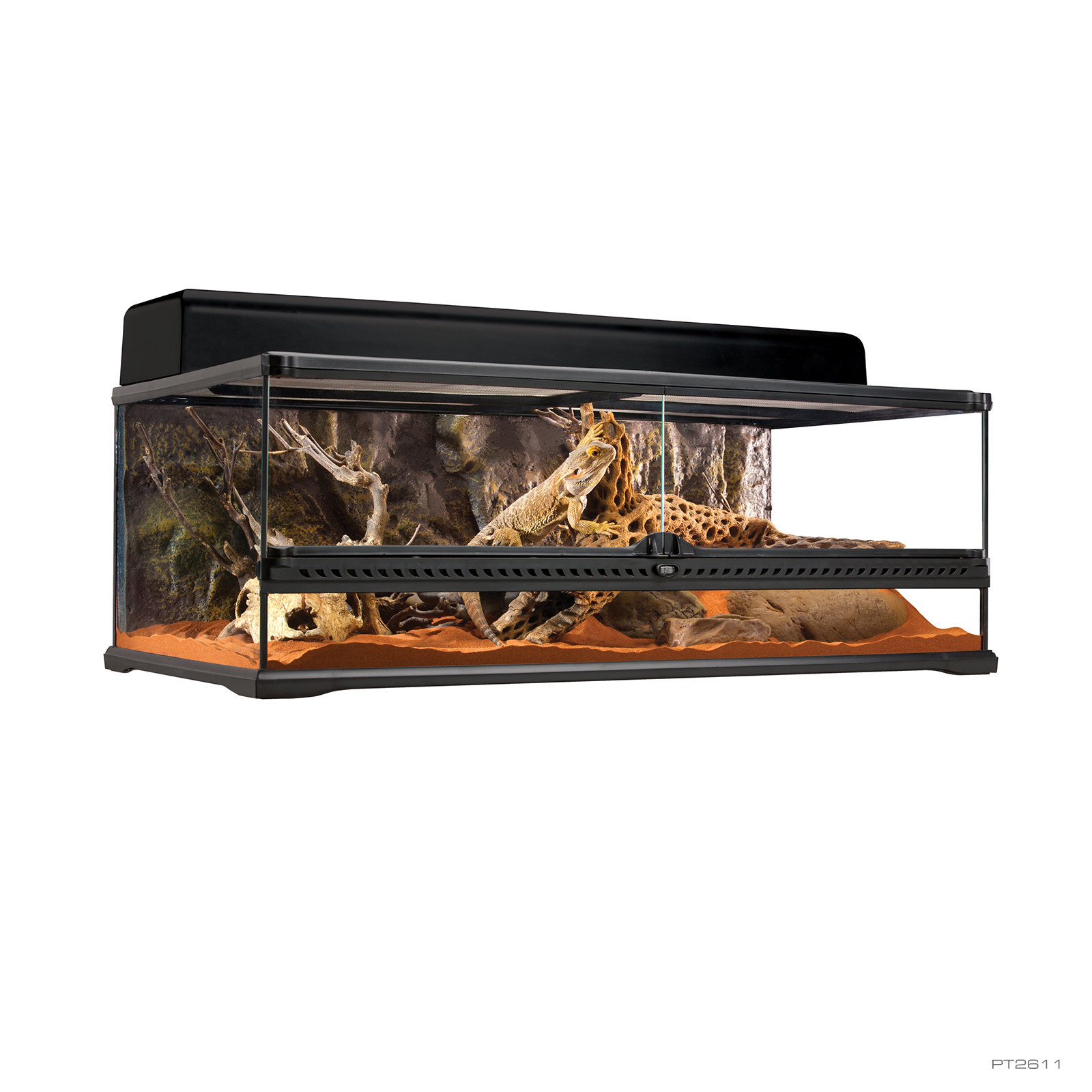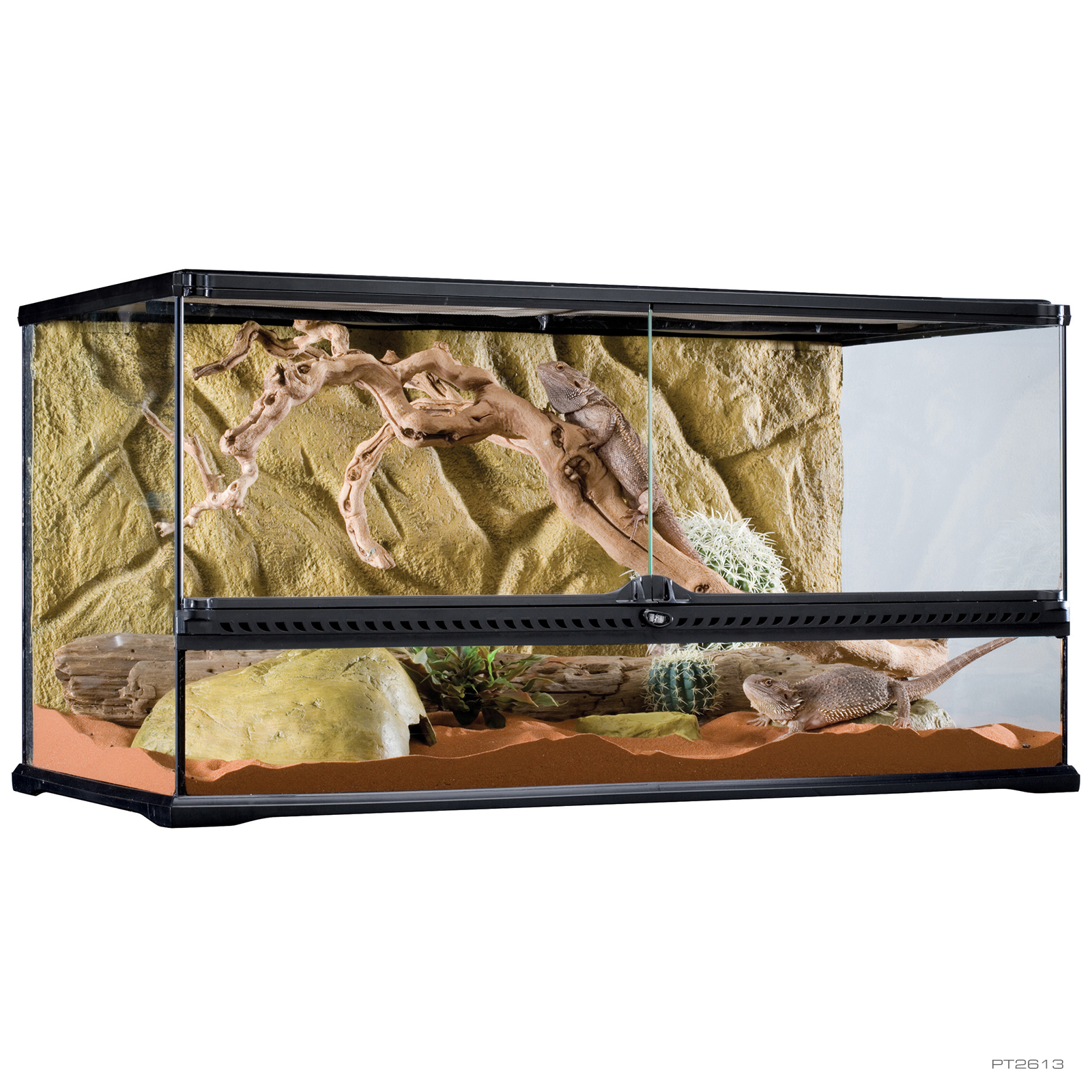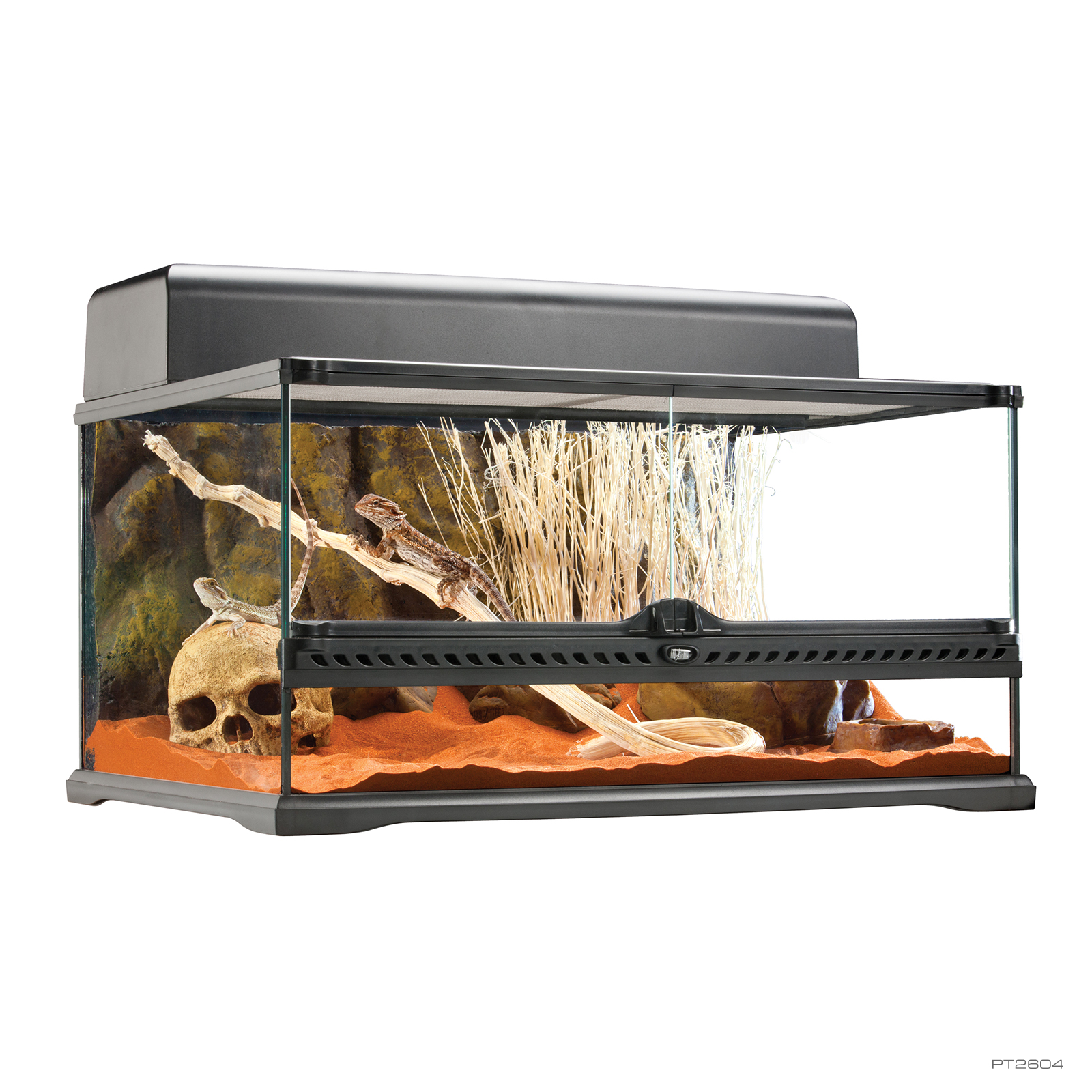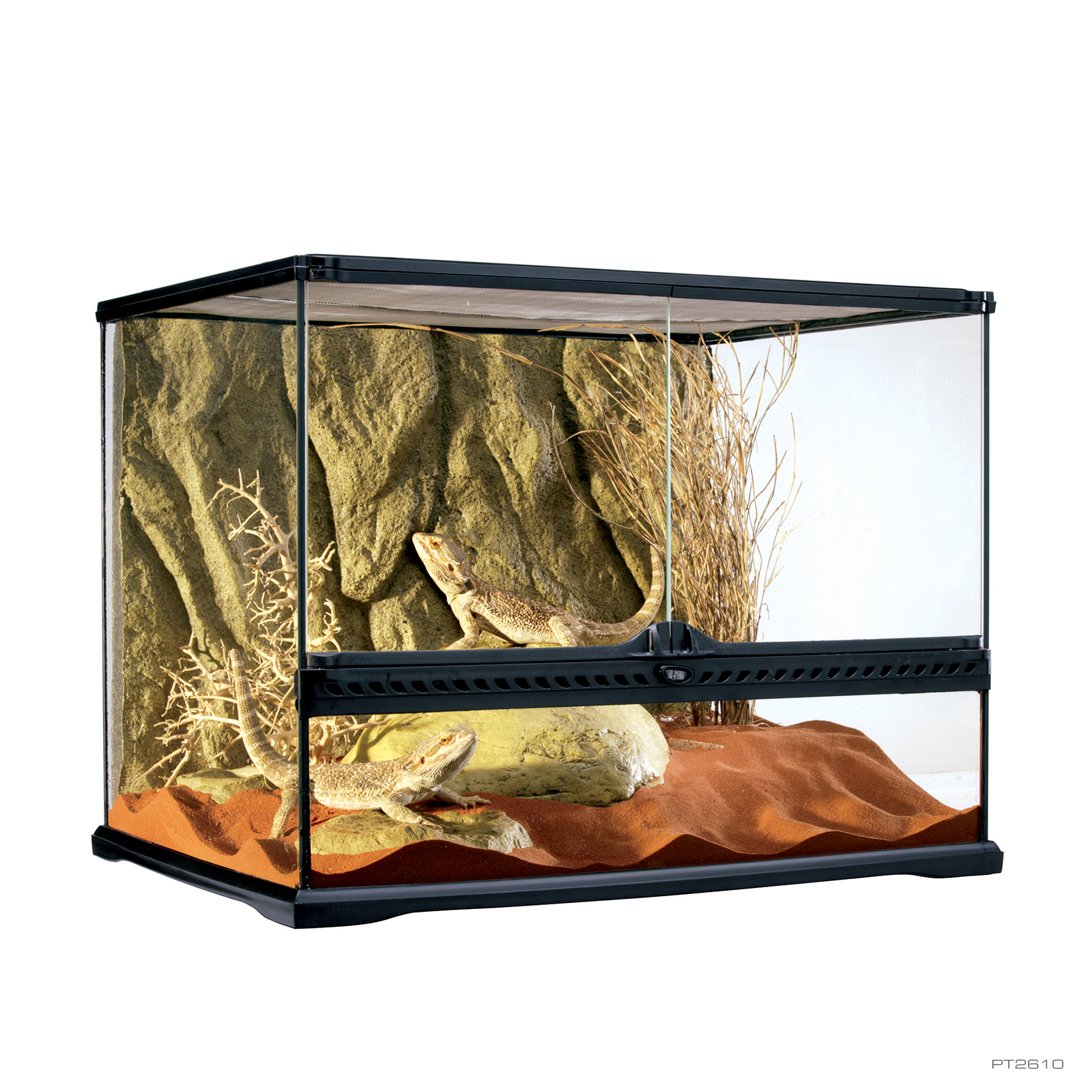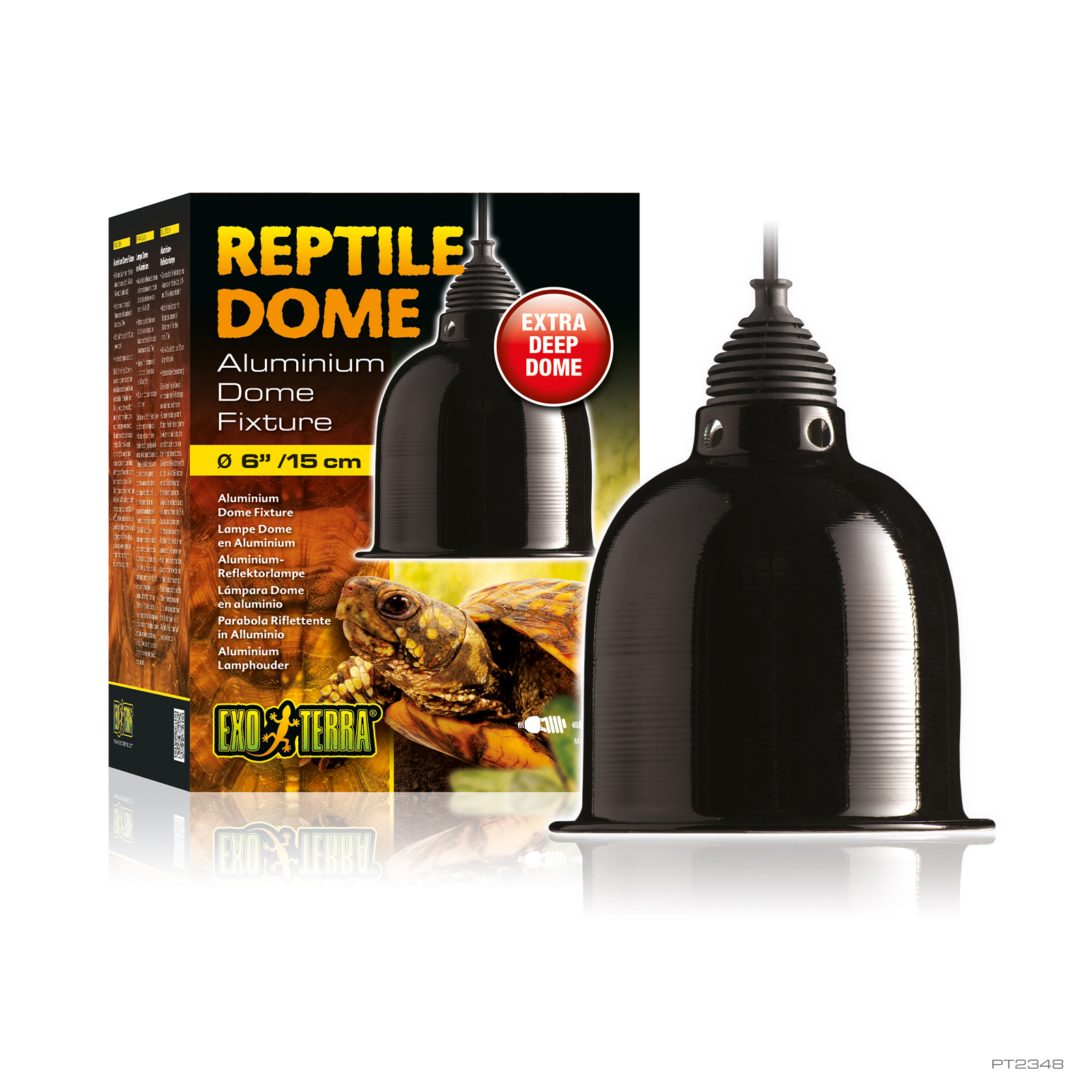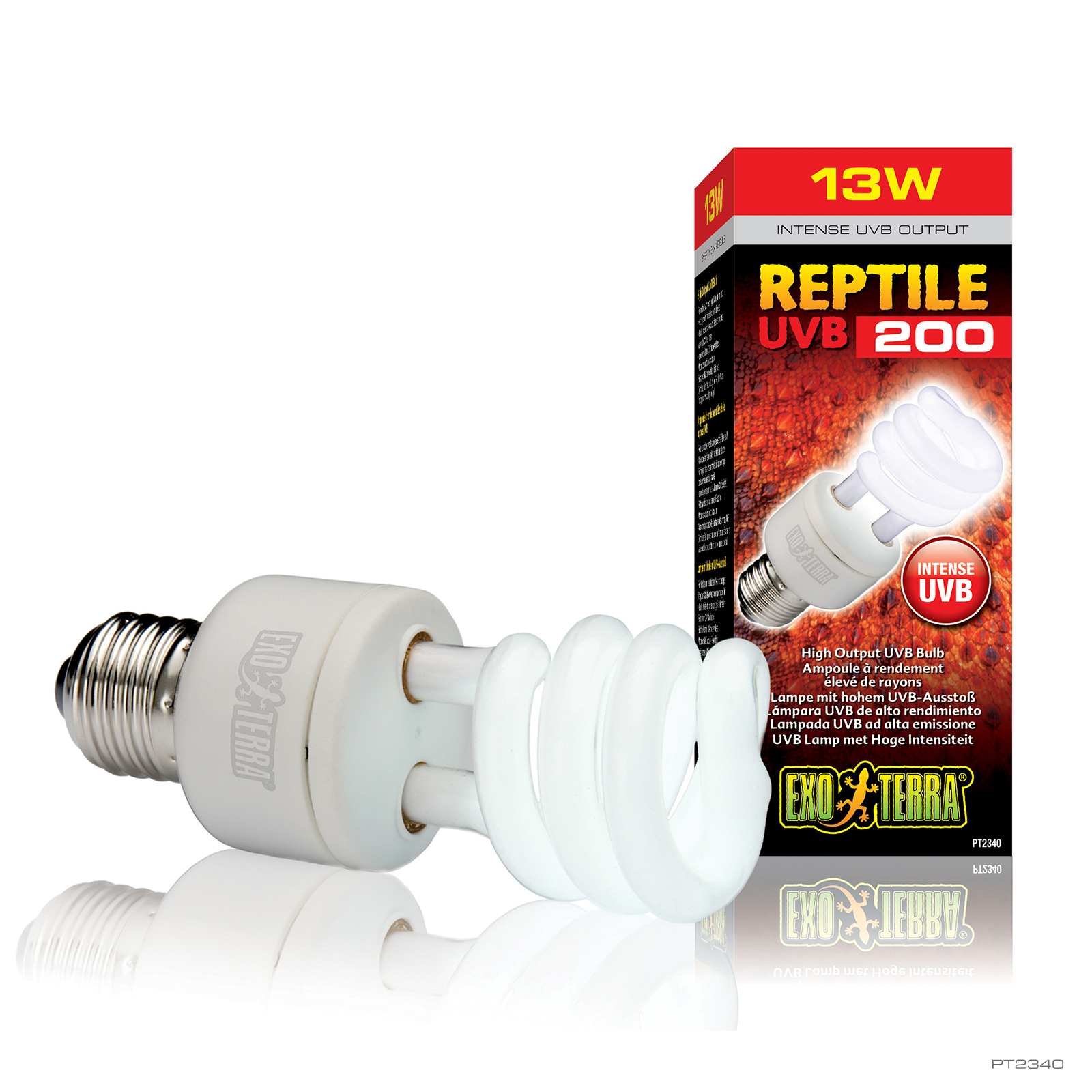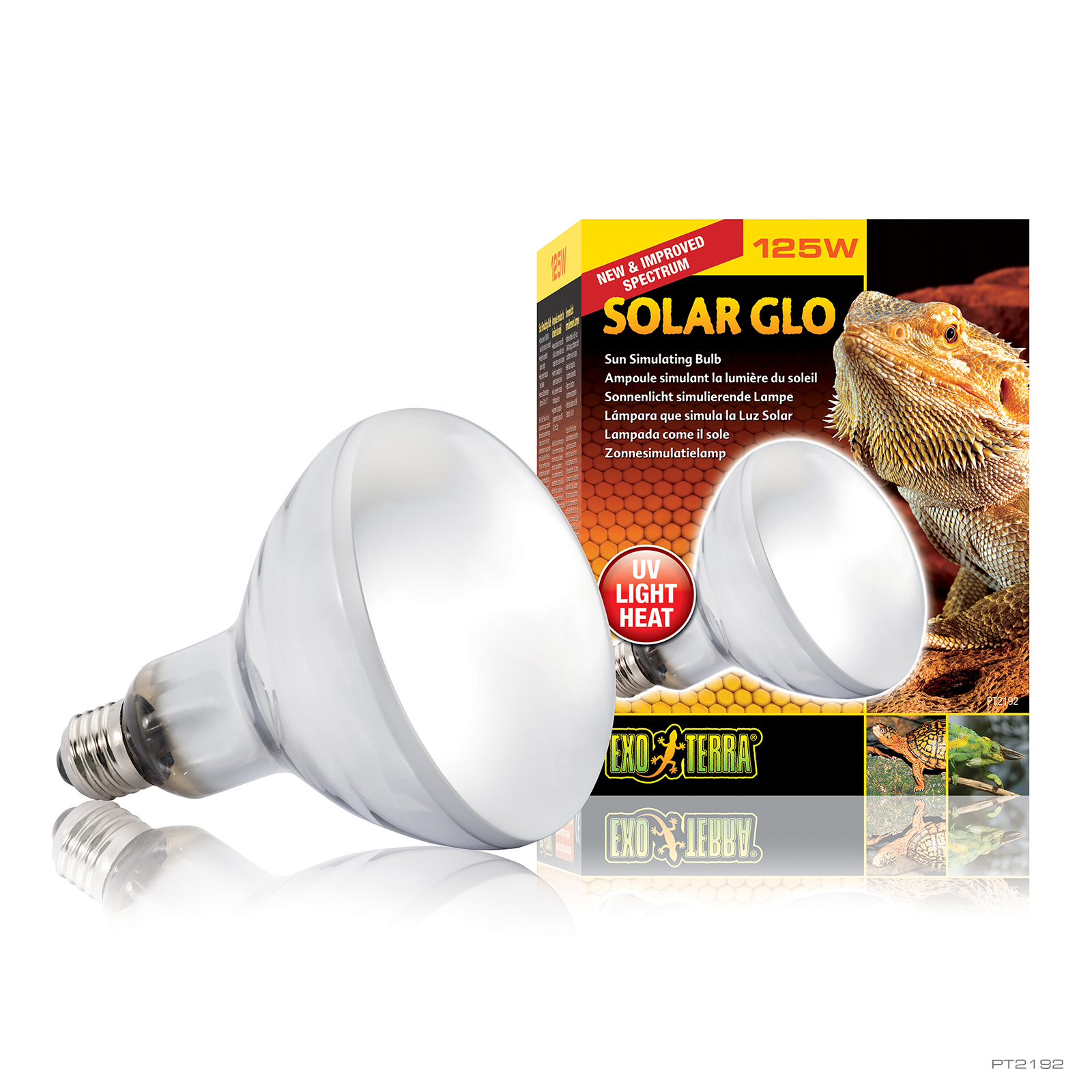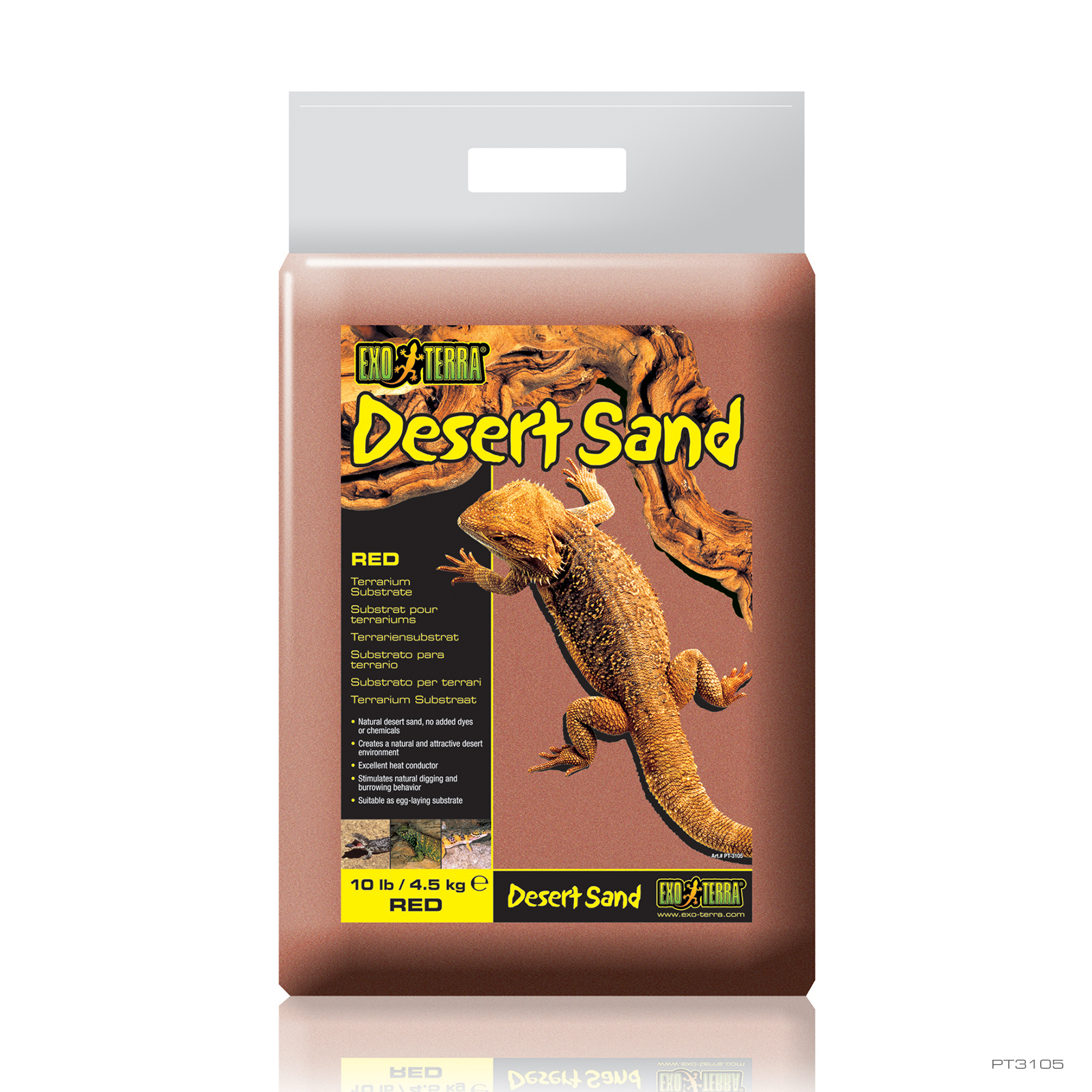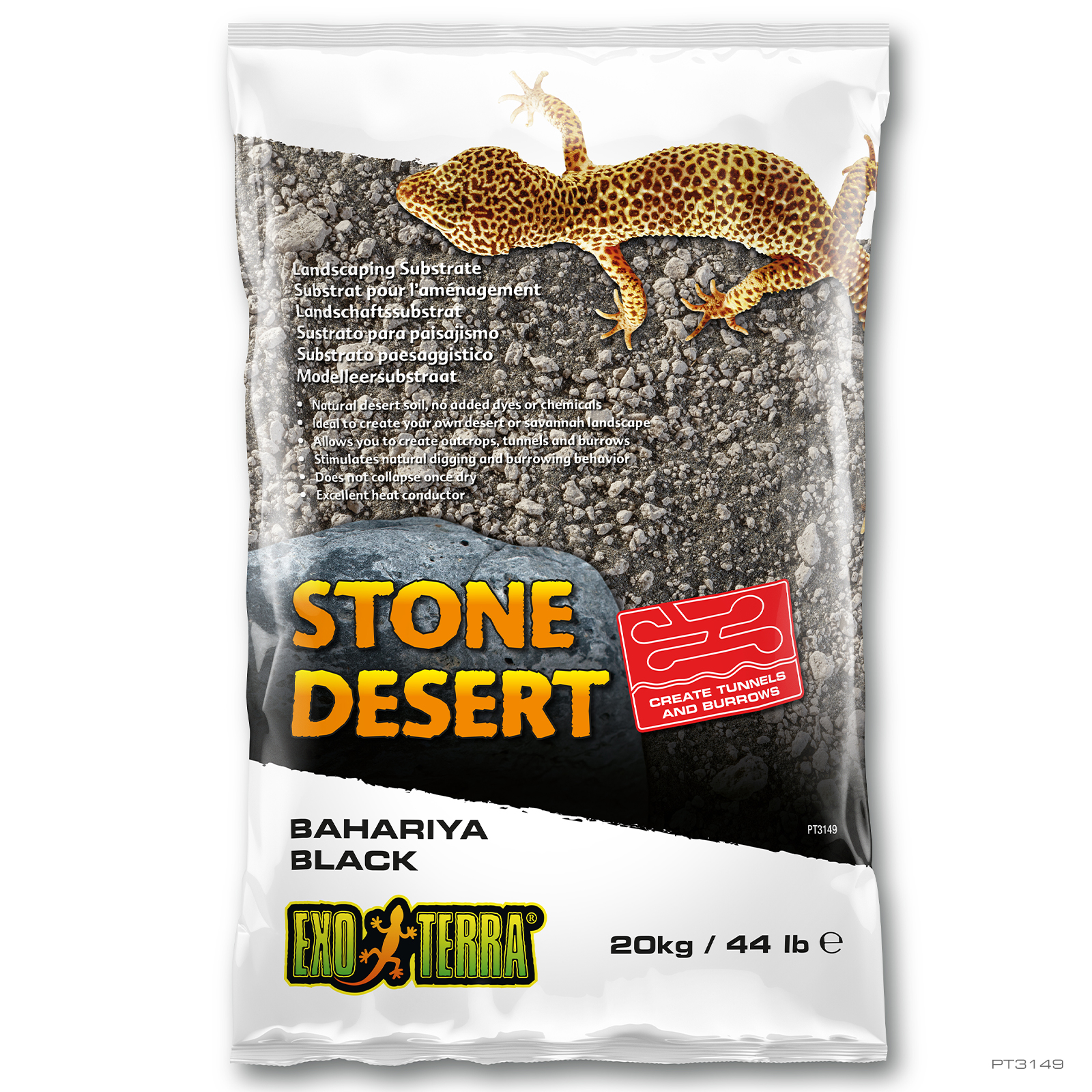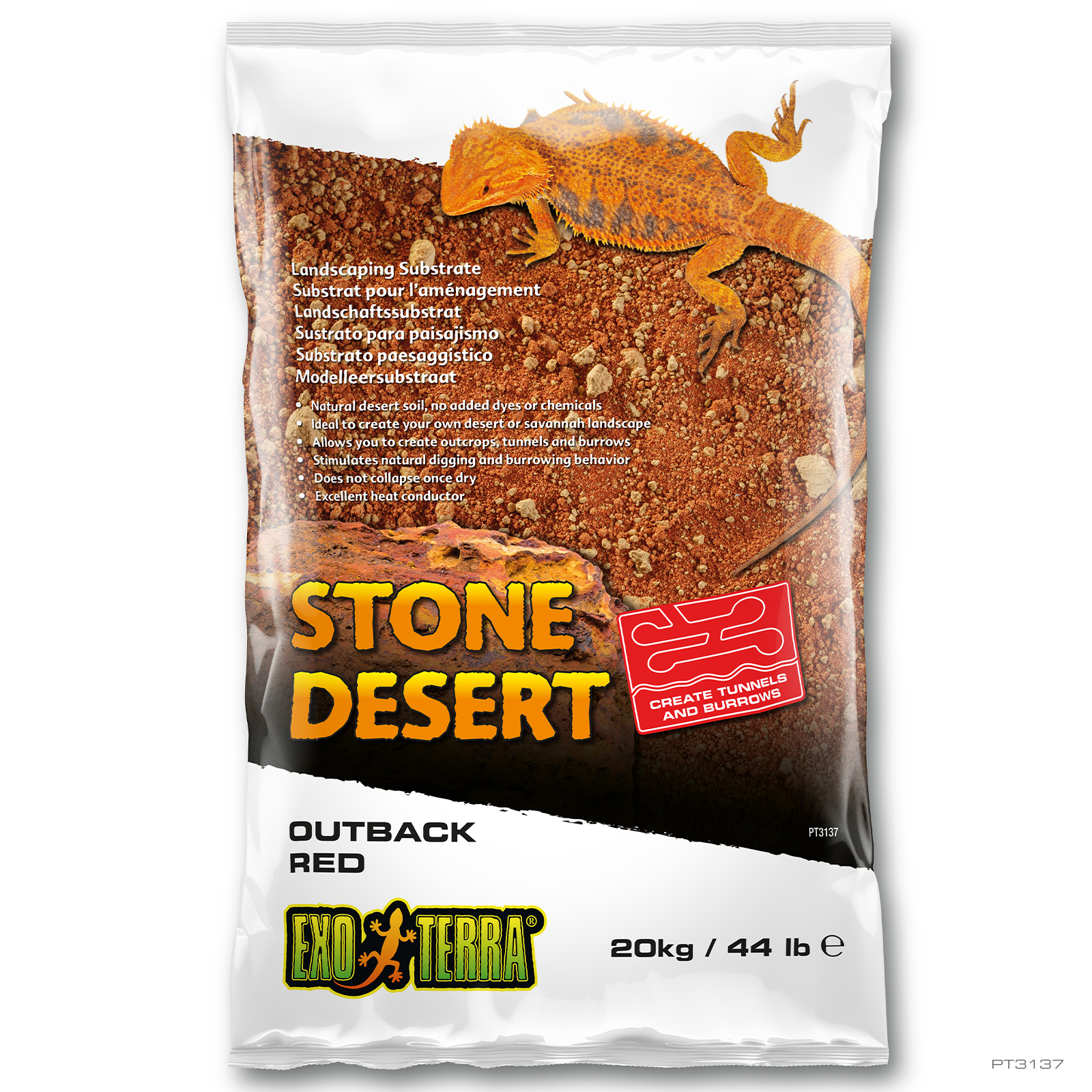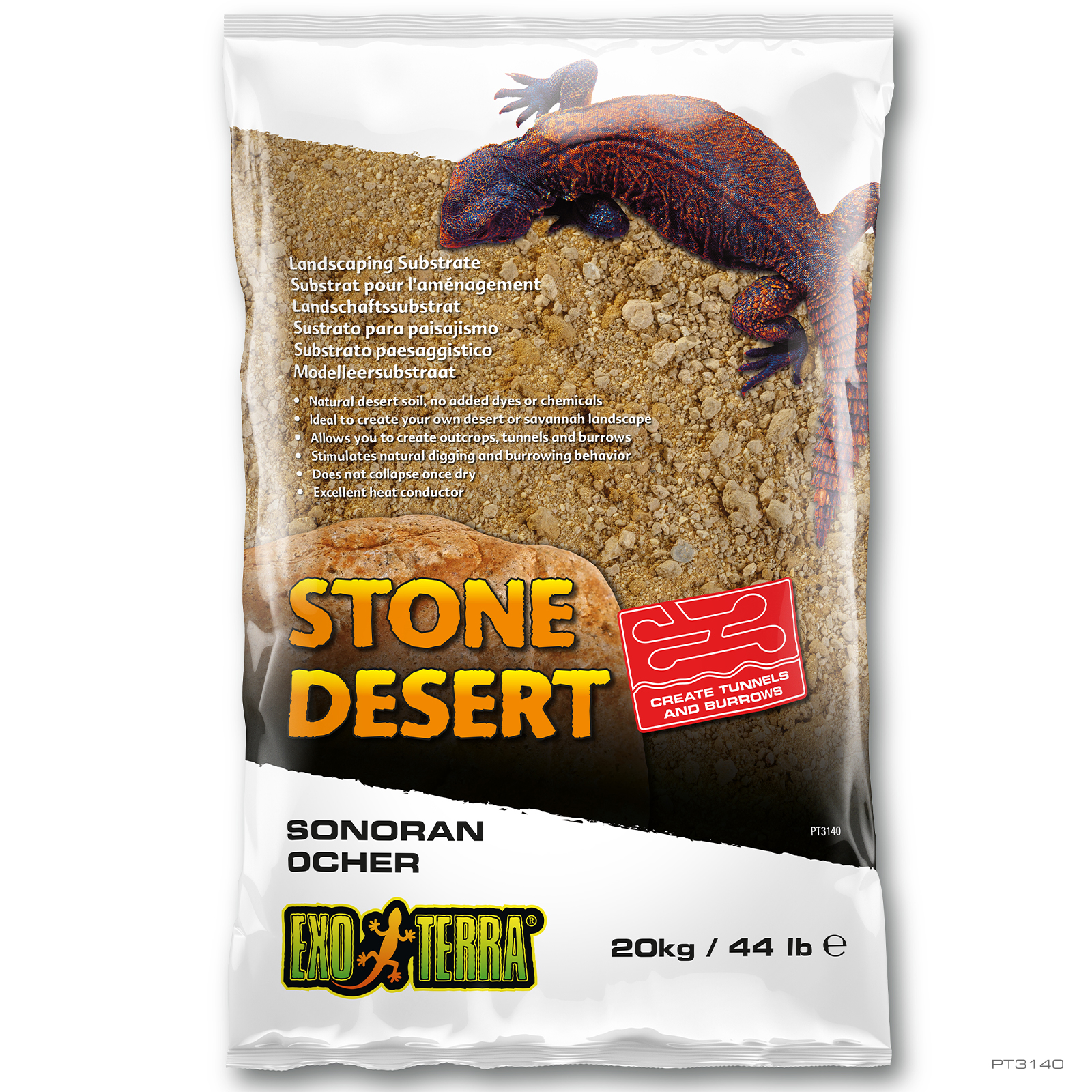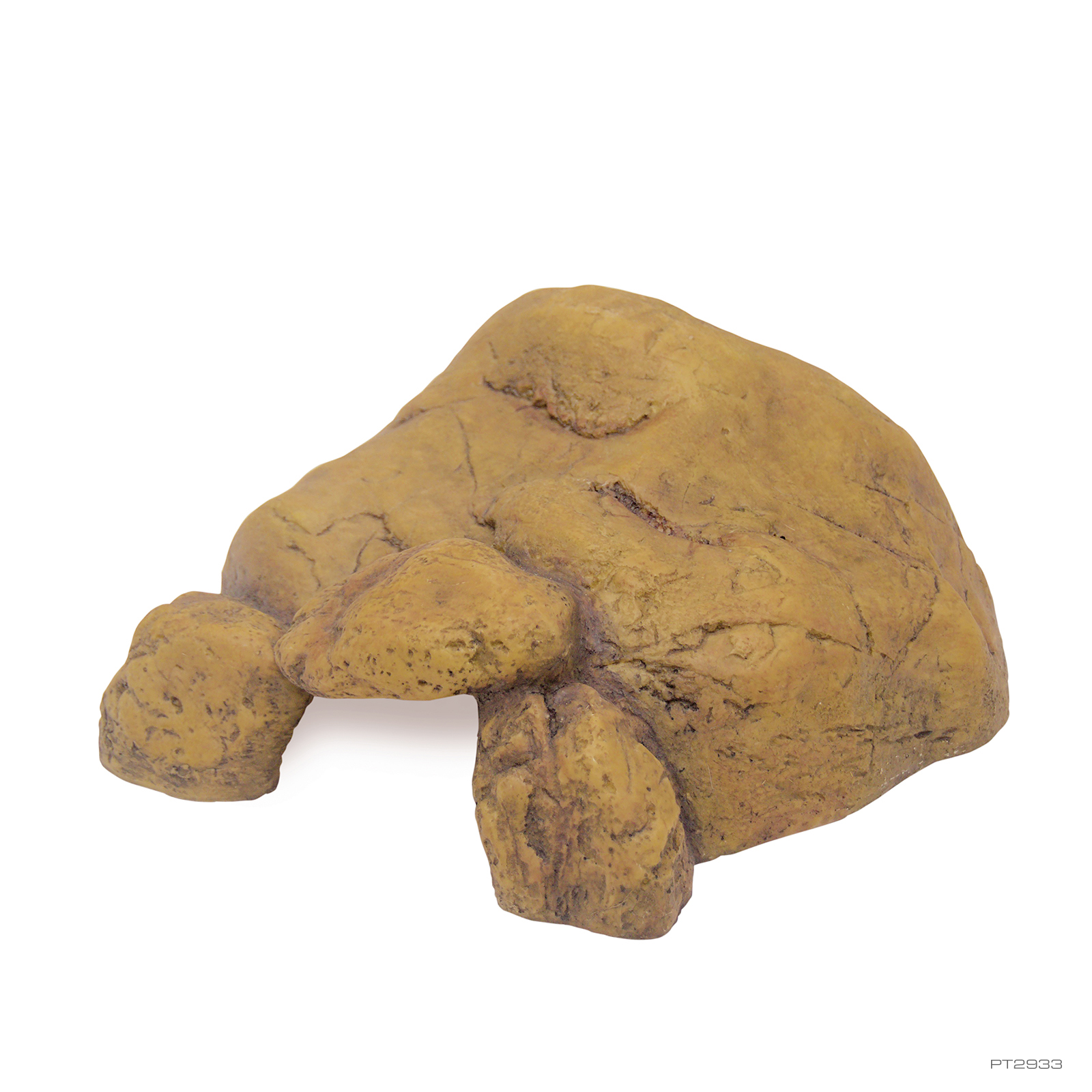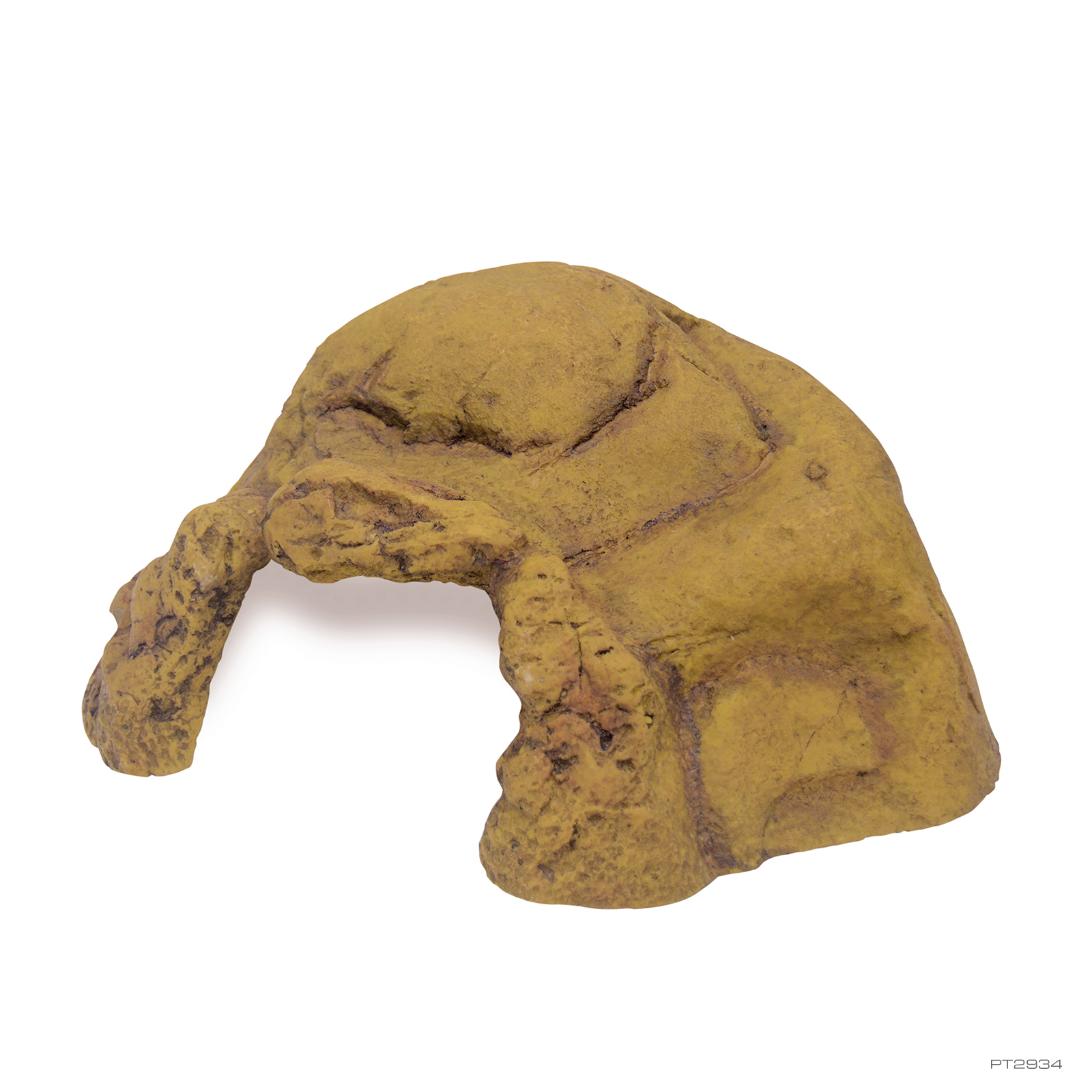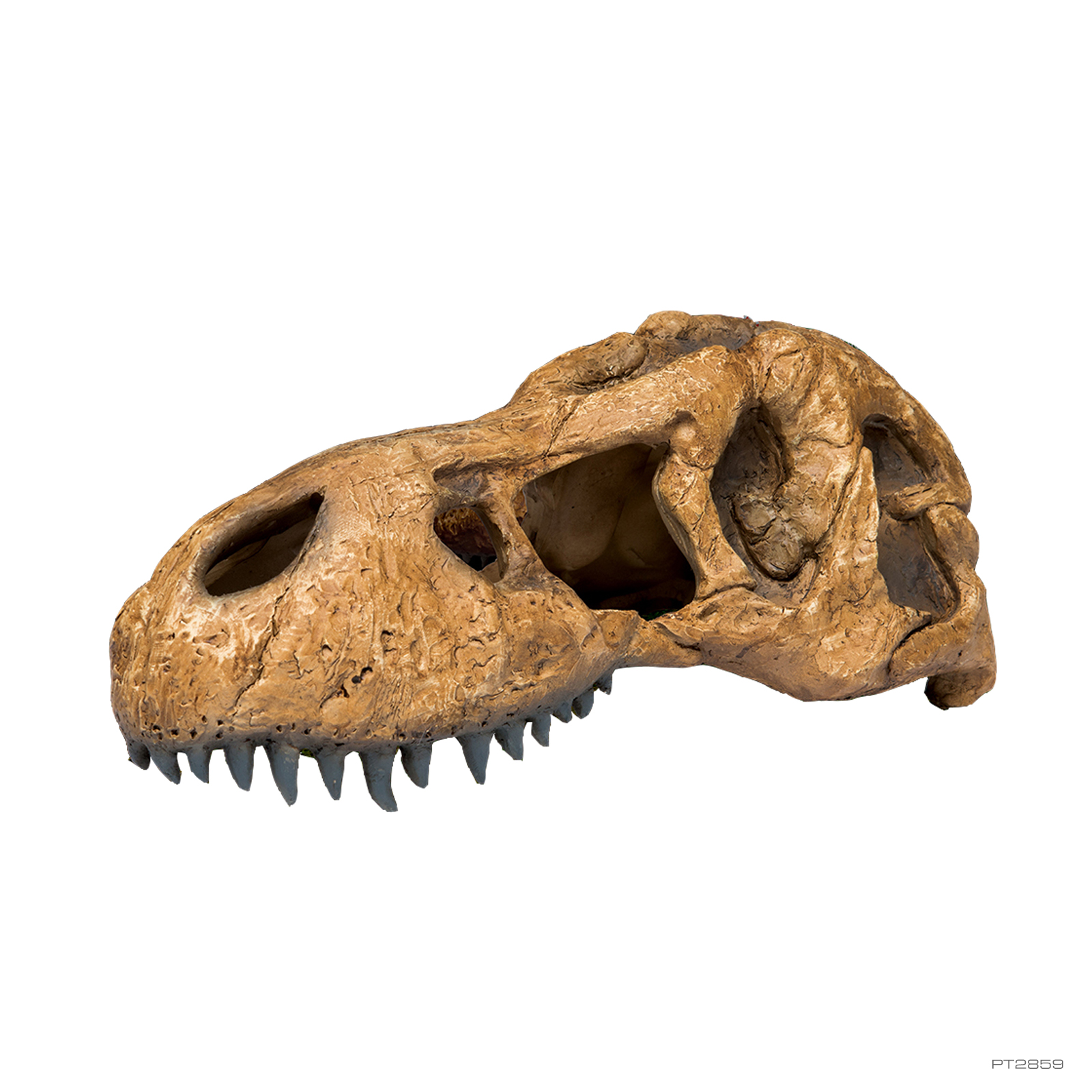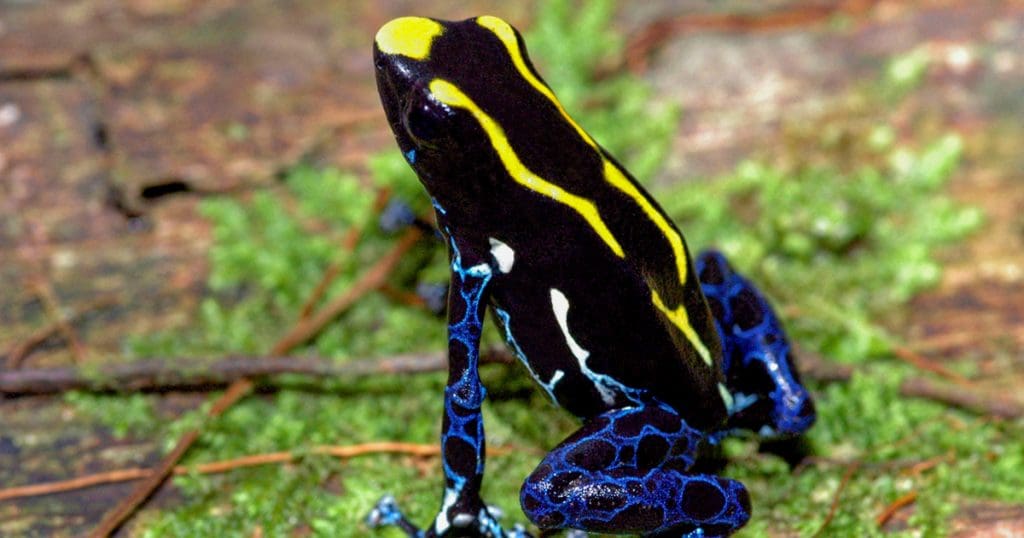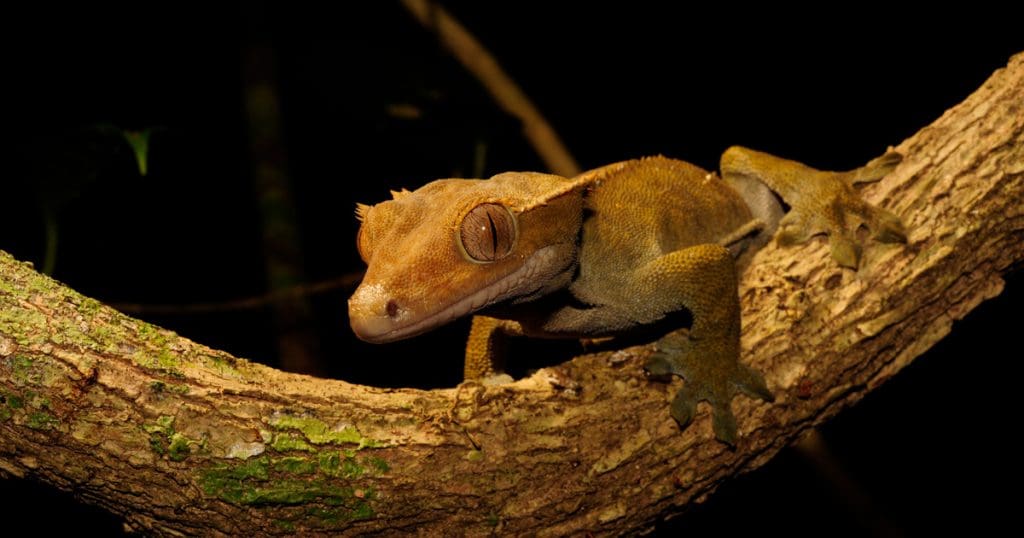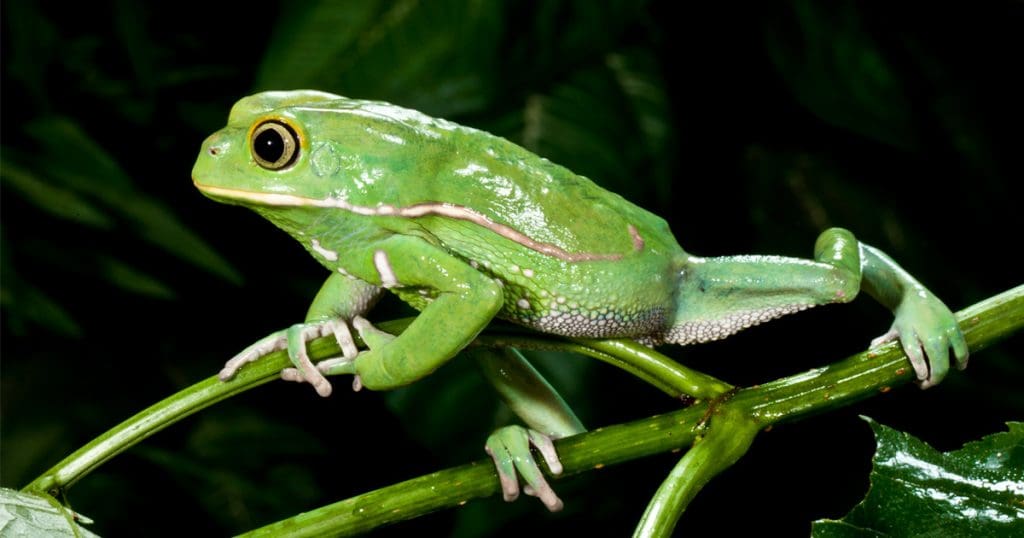
Pogona vitticeps
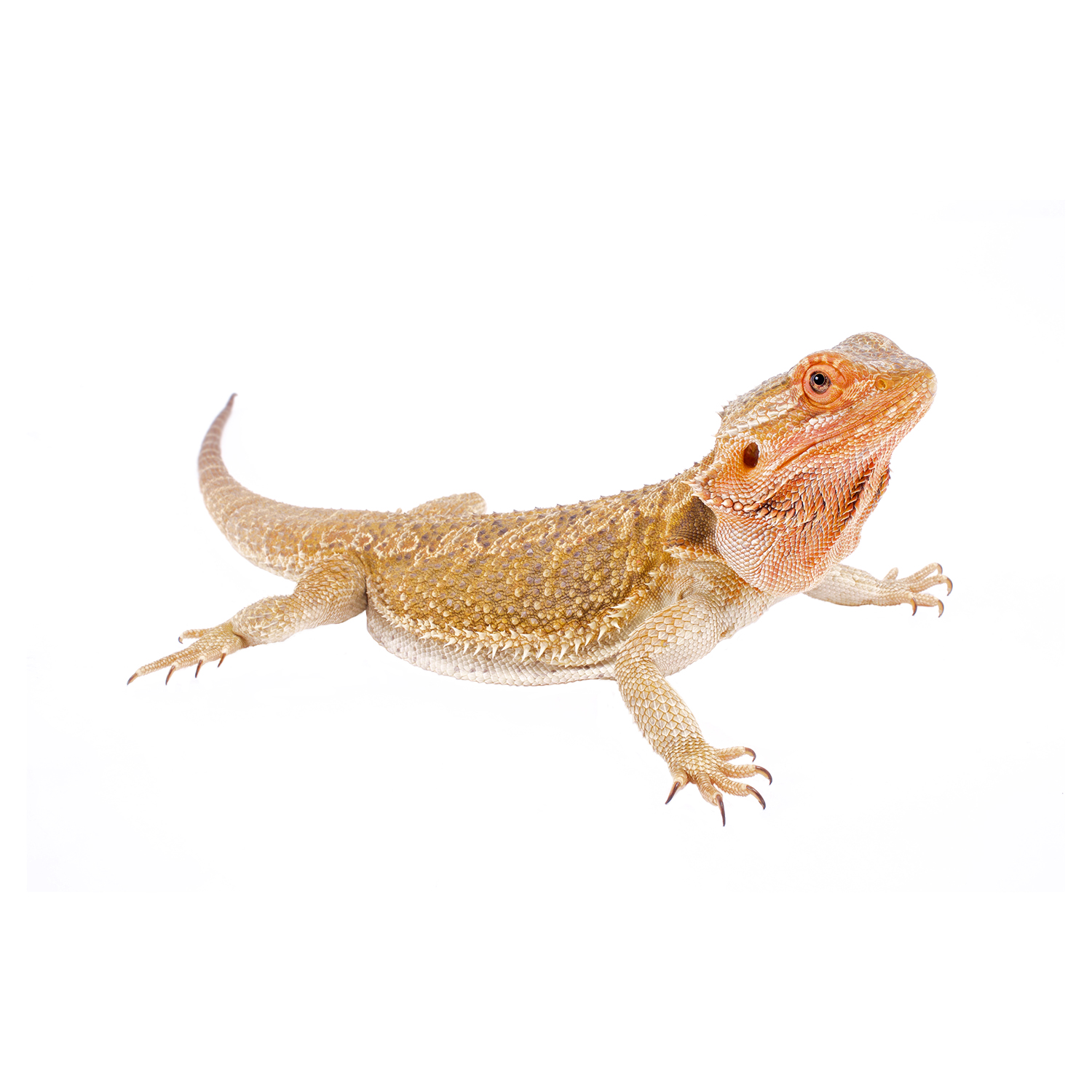

Bearded Dragon
Bearded Dragons are native to Australia. Both the scientific and the common name of the Bearded Dragon refer to the spiny “beard” (or pogon in Ancient Greek) which can be puffed up and darkened in coloration whenever the Bearded Dragon gets excited, stressed or wants to impress and opponent. No need to panic; the spines on the thorny triangular-shaped head and spiny torso of these Dragons may look frightening but are actually very soft when touched.
Their relatively small size and docile nature but especially their love for attention, make these gentle dragons an attractive species for both the beginning reptile enthusiast, advanced hobbyist and even for kids. And moreover, unlike night active creatures, your Bearded Dragon is awake when you are awake.
Bearded Dragons have been captive bred in the USA and Europe for over 30 years. Since Australia already banned the export of native fauna and flora in the 1960’s, all currently available Bearded Dragons are captive bred over generations.
Bearded Dragon youngsters are now readily available in their natural color and pattern, but also in a multitude of color morphs. The list of designer morphs available is extensive and still growing. Where it started with twisting and tweaking the color and pattern, the latest morphs even have a different scalation. There's a lot of cool morphs available with appealing names like Sandfire Red, Sandfire Yellow, Sandfire Pastel, Tangerine, Hypo Melanistic, Witblits, Paradox, Citrus Tiger, Lemon Fire and many more. But, as stated before, not only the colors can be isolated and enhanced by selective breeding, also some specific morphological characteristics, like size or scales can be engineered: German Giants (larger than the average Bearded Dragon), Leatherback (smooth back, no spikes), Silkback (smooth skin), etc.


History


The Bearded Dragon was first described in 1926 by Ernst Ahl as Amphibolurus vitticeps.
Storr proposed a revision of the species group Amphibolurus in 1982, and placed several species of the group under the new genus Pogona.
The general acceptance of this new genus Pogona was embraced reluctantly, but once Manthey & Schuster referred to the central bearded dragon as Pogona vitticeps in their 1999 book "Agamen", other authors started adopting it as well.
Since Australia banned the export of reptiles somewhere in the late 60's, all Bearded Dragons currently available in the market are captive bred over many generations. Bearded dragons where mainly bred in Germany, Belgium and the Netherlands by renowned hobbyists. During the 80's, several reptile breeders in the USA imported captive bred Bearded Dragons from Germany, and once the US breeding colonies where established, the commercial breeding of the dragons took a leap.
One of the first and most renowned breeder in particular was Robert Mailloux of the Sandfire Dragon Ranch. He started the Bearded Dragon breeding on a large scale and even managed, through selective breeding, to establish several color morphs.
Characteristics
Bearded Dragon’s belong to the family Agamidae and subfamily Amphibolurinae.
Bearded Dragons appear very robust with their broad, triangular shaped, head with rows of thorny scales and their complete body covered all over with spiky projections making them appear like a real dragon from a long lost era.
With their claws these lizards have a secure grip in the compacted sand and rock environment they live in.
When basking, Bearded Dragons will sit with their mouths wide open when temperatures get to hot.
Bearded Dragons are called “bearded” because of the lizard’s ability to enlarge its beard-like throat when it is threatened, as a territorial behavior or during courtship rituals. Dominant males can “darken” their “beard” to jet-black and start head bobbing to show dominance to smaller/younger males, or to impress females for mating. The females will respond to a male’s courtship rituals with a particular arm-waving gesture, if she’s ready to mate. Dominant males will often climb and lie on top of another bearded dragon in order to claim the best basking spot.
Males and females range from 16 to 24” or 40 to 60 cm in total length. The average hatchling size ranges from 3 ½ to 4" or 8 to 10cm.
Both males and females become sexually mature between 14 - 18 months of age. Unfortunately, it is not easy to determine the sex of your bearded dragons with certainty, before they reach sexual maturity. However, there are several methods that could provide an indication. Place the Bearded Dragon in front of you, with the tail towards you. Now very gently lift the tail and look at the base. In a male you will see 2 bulges left and right of the base of the tail, whereas with the female you will see 1 single bulge in the middle, right behind the anus. Another method is to candle the tails from above with a flashlight and look upwards to see the dual bulges in males or single bulge in a female. Once they reach sexual maturity, you can also look at the femoral pores on the inside of their thighs. These glands will be much more pronounced in males compared to females.
Distribution
Bearded Dragons are endemic to Central Australia and can be found in the semi-arid parts of Eastern Australia, including New South Wales, Northern Territory, Queensland, South Australia and Victoria.
In the Wild
Bearded Dragons are diurnal reptiles that live in arid, rocky, semi-desert regions, or arid open woodlands.
Bearded Dragons follow a ground-dwelling to semi-arboreal lifestyle and can be found basking on tree trunks & stumps, branches, fence posts and rocky outcrops in the mornings and afternoons. Although primarily diurnal, they can also be found late at night, basking on some rocky outcrops to absorb the accumulated heat. During the hottest hours of the day, they retreat in their burrows or caves to shield themselves from the extreme temperatures. They use these caves and burrows also at night to protect themselves from predators.
Bearded Dragons will actively thermoregulate their body temperature by moving from hot basking area’s to cooler spots, as well as by shifting their skin color shade from a darker (to absorb more heat) to a lighter grey/brown (deflecting sunlight), and vice versa.
Dominant male Bearded Dragons prefer higher basking perches as this will show their dominance to the group. From this elevated position, the dominant male is on the lookout for food, rival males and potential predators. If a rival male approaches the dominant male's territory, he will rush down from his elevated position and run towards the approaching opponent with open mouth, puffed-up beard, puffing and hissing. That should be sufficient to bring the rival male to take a submissive stance to show that he complies with the hierarchy.
Bearded dragons sometimes get too hot during extensive sunbathing, but rather than leaving their favourite basking spot, they open their mouths to lower their body temperature by applying evaporative cooling.
During the colder winter months, when there's less food available and the temperatures are not ideal, the Bearded Dragons go through a brumation period for a couple of weeks. They retreat in their burrows and will no longer eat, and only drink sporadically. This brumation period is also important to induce the hormonal changes needed for the mating and breeding process during spring.
Bearded dragons usually breed during spring, from September through November. About 4-6 weeks after copulation the female Bearded Dragon will lay a clutch of 16-30 eggs and might repeat this up to 3-4 times throughout the egg-laying season. Female Bearded dragons have a unique mode of delayed fertilization or "Amphigonia retardata", meaning, they can store sperm from a single mating and fertilise future eggs without any further copulation.
Bearded Dragons are omnivorous lizards, meaning they feed on a variety of invertebrates, vegetation, fruits and even vertebrates, like other lizards.
Seasons in Australia are at opposite times of those found in our northern hemisphere. The mild 24-28°C or 75-82°F average temperatures during spring last from September through November, while the averages during the hot summer reach between 30-34°C or 86-93°F and last from December up to February. Autumn starts in March through May with temperatures of between 18-24°C or 64-75°F, cooling down towards winter, lasting from June until August, with temperatures between 14-22°C or 57-72°F.



In the Terrarium
Bearded Dragons follow a ground-dwelling to semi-arboreal lifestyle, sunbathing on an elevated hot spot in their terrarium, foraging on the ground for food or hide in their burrow or cave. For this reason, vertically orientated terrariums work best for Bearded Dragons. Elevated platforms, for the Bearded Dragons to sunbathe, can be nicely incorporated in the terrarium interior design.
Bearded Dragons have a docile nature and can be kept solitary or in small groups of 1 male with up to 3 females. The interaction between the animals in small groups, like head-bobbing (reflects dominance) or arm-waving (reflects submissiveness or feeling intimidated) but also the feeding frenzy while chasing crickets, increases the viewing pleasure and stimulates their natural- and mating behavior.
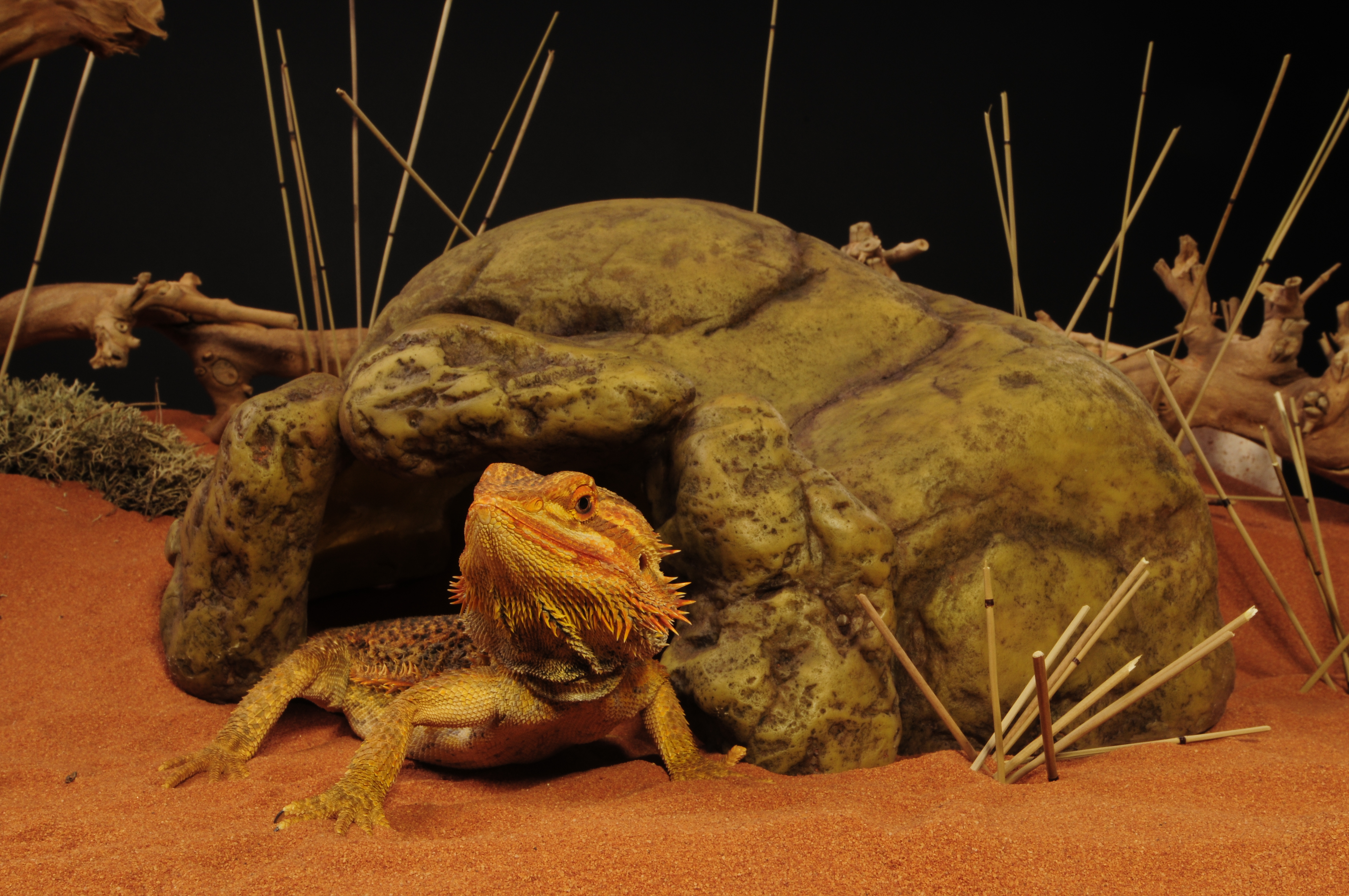

Terrarium
Exo Terra® Natural Terrariums, designed by European herpetologists, offer several housing options for Bearded Dragons. These glass terrariums feature front opening doors, allowing easy access for maintenance and feeding and a unique double ventilation system with full screen stainless steel top. The full screen stainless steel top allows ultraviolet rays from UVB lights to penetrate deep inside the enclosure. In the back of the screen cover are 5 closable wire or tube inlets on both sides to facilitate the installation of powered accessories.
The Exo Terra® Natural Terrariums Medium/Low, Medium/Wide, Large/Low and Large/wide provide good ventilation and adequate floor space to raise groups of hatchling or young Bearded Dragons or to maintain groups of 1 adult Bearded Dragon male and 1 adult female:
The set-up can be a simple “sterile-type set-up" with an Exo Terra® Sand Mat, a Water Dish and Reptile Cave or any other decorative Exo Terra® hide-out. Or you can offer your Bearded Dragons a more natural, “bio-active type set-up” by creating your own desert or savannah landscape with Exo Terra® Stone Desert, including cool-humid burrows as well as warmer elevated basking areas.
Exo Terra® also offers Bearded Dragon Starter Kits which come with all the components necessary to a successful start. All the features of these kits are based on information on captive husbandry from renowned Bearded Dragon breeders.
Never house 2 male Bearded Dragons together in one terrarium as they tend to be very territorial.
DISCLAIMER In regards to the pet species and number of specimens to be kept in a terrarium, always comply with the species specific Rules and Regulations in your Country of residence.
DISCLAIMER The terrarium should be placed in a room receiving only indirect light from windows. Do not place the Terrarium near a window where it can receive direct sunlight, as this could cause the terrarium to overheat and stress or kill your Bearded Dragon.
Lighting
Bearded Dragons are mainly diurnal, meaning they’re active during daylight. Since Bearded Dragons are heliophilic, meaning they are attracted to sunlight, we have to provide them with a combination of sufficient visual light, UVA, UVB and Heat rays during daytime. Proper UVB Lighting is VITAL for your Bearded Dragons.
A 12-hour day/night cycle is an adequate photoperiod for the healthy all-year-round keeping of your Bearded Dragons. The more natural approach, and to induce breeding, is to provide 14 hours of daylight and 10 hours of nighttime during the summer months, and reduce the daylight cycle to 10 hours daylight and 14 hours nighttime during the winter months.
There are various solutions to offer your Bearded Dragons quality lighting. You can either go for all-in-one bulbs like the Exo Terra® Solar Glo or Solar Ray, which provide optimal levels of UVA, UVB, visual light and heat all in one bulb! Or you can choose for a combination of fluorescent UVB lighting (like the Reptile UVB200 linear or Reptile UVB200 compact) in combination with an incandescent heat bulb (like the Intense Basking Spot or Halogen Basking Spot).
It is very important to provide your Bearded Dragons with a proper basking space that combines light, heat and UVB. The correct UVB wavelength assures that provitamin D3 (7-Dehydrocholesterol) can be converted into pre-Vitamin D3. Once this is formed, the heat rays will then provide the correct temperature for the thermal isomerisation into actual Vitamin D3. Without the combination of light, heat and UVB, your Bearded Dragons cannot produce the necessary Vitamin D3 to absorb calcium from their food. A major dietary problem in captive reptiles is the low assimilation of calcium from their daily food. Calcium is vital for bone growth and maintenance, muscle function, and many of the body’s most important metabolic functions.
Heating
Monitoring
Bearded Dragons require a specific temperature range both during night and the day to thrive (see “Heating”).
To have a clear indication of the temperature gradients inside the terrarium, it is best to use 2 Exo Terra® Digital or Analog Thermometers, one placed the cooler side of the Terrarium, one at the warmer side. This helps you to monitor the preferred temperatures for your reptiles.
The safest option to assure that your reptiles receive the right temperature is the use of a Thermostat. The Exo Terra® Thermostats will also help to prevent overheating and undercooling during hot summer days or cold winter nights. With the Exo Terra® Thermostats you can create a well-controlled heating system that allows you to maintain the required temperature conditions similar to those found in your animal's environment.
Exo Terra® offers a wide range of Thermostats to meet every possible application:
With the Exo Terra® 600W Thermostat with Day/Night Timer & Dual Receptacles, for instance, you can create a well-controlled 24-hour heating system that allows you to maintain the required temperature conditions similar to those found in a desert or tropical environment. Both the daytime and nighttime temperatures can be set and controlled individually to guarantee safe daytime-nighttime temperature fluctuations for your reptiles. The Dual Receptacles allow you to control 2 separate heating devices, 1 during daytime, 1 during night-time (for instance: 1 incandescent heat bulb during daytime & 1 Heat Mat during night-time or for 24-hour use).
Visit our Thermostat page for more information about the different functionalities of our Thermostats.
Substrates
The set-up can be a simple “sterile-type set-up" with an Exo Terra® Sand Mat or you can offer your Bearded Dragons a more natural, “bio-active type set-up” by creating your own desert or savannah landscape with Exo Terra Stone Desert.
1. “sterile-type set-up” The Exo Terra® Sand Mat is a convenient substrate choice especially for hatchling and young but also for adult Bearded Dragons. The Sand Mat simulates the substrate in the Bearded Dragon’s natural environment, namely compacted sand with smaller rock particles. On this surface, the Bearded Dragon has a firm grip and can move swiftly to catch its prey.
2. “bio-active type set-up” The Exo Terra® Stone Desert mimics the natural soil found in the rocky, dry grassland and desert regions where Bearded Dragons live. Exo Terra’s Stone Desert allows you to create your own desert or savannah landscape, including cool-humid burrows as well as warmer elevated basking areas. The cool-humid burrows allow your reptiles to absorb the much-needed moisture via their skin while sleeping or hiding, while the warmer elevated basking areas help your reptiles to thermoregulate by offering various important temperature gradients. Lightly moisten the Stone Desert substrate to shape naturalistic hills, burrows and basking platforms for your animals. Once dry, the Stone Desert will retain its shape, while still allowing your reptiles to further execute their natural digging and burrowing behavior. Stone Desert can also be used to secure heavy decor items, like branches or rock formations.
Plants
Adding a mix of decorative live and Exo Terra® artificial plants to your terrarium will provide extra cover and increase the aesthetics of the terrarium interior design.
Many hobbyists choose to introduce live plants in pots that are buried in the substrate and concealed with decor items, like cork bark or rocks. The Exo Terra® Snake Bowl is ideal for use as a decorative planting pot. Its extra deep design makes it suitable for small to medium live terrarium plants. The Exo Terra® Large and X-Large Water Dish can be used for multiple plants. Planting your live plants in Exo Terra® dishes prevents them from being dug up by your Dragons.
DISCLAIMER Make sure they have no pests before introduction and rinse leaves thoroughly to remove any pesticide residues.
Exo Terra® offers a wide range of artificial plant with the same advantages as live plants; they're decorative, they provide shade and they create hiding spots and visual barriers to let your reptiles and amphibians experience an increased feeling of safety and reduced stress. Exo Terra's artificial plants are exact copies of their natural counterparts to blend in well with live plants but are much easier to maintain. A combination of live plants and Exo Terra's artificial plants allows you to fully plant a terrarium, even in the hottest or driest parts.
Exo Terra's Ground Cover Plants are easy to clean & maintain, while the weighted base allows you to easily position the plant after maintenance.
Hide Outs
Exo Terra® offers a variety of hide-outs to match everyone’s taste, but the main goal is always to provide a safe refuge for your Bearded Dragon to hide and sleep during nighttime hours or during daytime when they search for shade or privacy. Most Decorative Hides will also function as climbing space and basking platform because they create 3-D levels in the terrarium, ideal for the Dragons to thermoregulate. Whether you like the more natural looking Reptile Caves, or you prefer the Skulls, Dinosaur Eggs, or other designs, always make sure that the moisture inside the cave is somewhat higher (60-70%) than the average humidity in the terrarium.
Exo Terra® created various ceramic caves designed specifically to facilitate recreating that natural micro-climate. The eco-friendly Exo Terra® Wet Rock & Wet Log Ceramic Caves offer your reptiles, amphibians or invertebrates a secure place to hide and sleep, while the moist microclimate will support thermo-regulation, hydration, and aid the natural shedding process of reptiles. The unique hygroscopic properties of the ceramic material regulate the cave’s humidity and temperature in a natural way by absorbing and slowly releasing moisture from the water reservoir.
By simply adding moistened Exo Terra® Forest Moss or Sphagnum Moss, the Exo Terra® Wet Rock or Wet Log provide an ideal egg-laying site for various species of reptiles, amphibians and invertebrates.
When housing multiple Bearded Dragons in one terrarium, ensure that each animal has its own hide-out to prevent stress.
Decor
Landscaping a terrarium will encourage activity and exploratory behaviours. Next to the necessary items like hide-outs and plants - the terrarium can be “beautified” with some additional decor items. Care however needs to be given to not over clutter the open space in the terrarium.
Exo Terra® offers a wide variety of innovative decor items like Reptile Caves & Hides, Rock Outcrops, Skulls, Dinosaur Eggs, Ground Cover Plants, Sandblasted Grapevine, etc. - all which add next to personalizing accents, some more environment enrichment and features.
If you plan on keeping a small group of Bearded Dragons then make sure to provide multiple hiding places, so every individual can retreat into its own resting area.
The Exo Terra® Snake Bowl and Water Dishes, can be used as decorative planting pots, to prevent your Dragons from digging up your succulent plants.
Nutrition
In the wild, Bearded Dragons are omnivorous lizards, meaning they feed on a variety of invertebrates, vegetation, fruits and even vertebrates, like other lizards. Bearded Dragons will do well on a variety of invertebrates, vegetables and fruits. The insect/vegetable ratio in the diet of bearded dragons varies throughout their lifecycle. The diet of a Bearded Dragon less than a year old should consist of about 70% insects and 30% vegetables. This diet will inversely proportionally shift to approx. 70% vegetables and 30% insects once your Bearded Dragon grows to adulthood.
Bearded Dragons should be fed a variety of live, canned or vacuum-packed insects of appropriate size. As a general rule the maximum size of the insects should be the width of the animal’s head. Offer as much variety of insects, in your Bearded Dragon's diet, as possible, to make sure that your dragon receives all possible essential nutrients. All live insects should be gut-loaded with nutritious foods, like apple slices, sweet potato, oranges, cereals, bee pollen, etc. 24-48 hours prior to being fed to your dragon.
Because commercially raised insects tend to be deficient in calcium and several vitamins, they must be supplemented by coating with a reptile vitamin and mineral supplement such as Exo Terra® Multi Vitamin blended with an equal part Calcium. Always dust your feeder insects with a 1:1 mix of Exo Terra® Multi Vitamin and Calcium + D3 powder supplement using the “shake & bake” method of coating insects.
The Exo Terra® Worm Dish with a curved upper lip that prevents wax worms and mealworms from escaping is ideal for this feeding these species. The dish should be cleaned regularly and allowed to thoroughly dry before refilling with worms.
Exo Terra® Canned or Vacuum-Packed insects can be fed right out of the can/pouch as these insects are well fed and vitamin-calcium coated.
Exo Terra® offers 11 varieties of Canned and Vacuum-Packed Foods which allow you to bring more variety in your Bearded Dragon's diet. Bearded Dragons will readily accept canned or vacuum-packed foods if you use tweezers to make the insects appear to be alive. Just hold the insect in front of the Bearded Dragon and slowly wiggle it so it appears to be moving. Loosen the tweezers as soon as the dragon grabs the insect. The Exo Terra® Canned and Vacuum-Packed Specialty Reptile Foods are a convenient way to feed insect eating reptiles, turtles, amphibians, fish and birds. These insects (and snails) have been cooked in the can to maintain nutritional value, flavor and aroma. The retorting process also softens the exoskeleton of the insects for easier digestion and breaks the bonds between the collagen protein to make it absorbable by reptiles. Collagen is an important fiber that aids in building bone, cartilage, skin and claw structures. Canned and Vacuum-Packed insects have the same nutritional value as live insects but are easier to digest. Visit our Canned and Vacuum-Packed Foods webpage for more information.
Exo Terra® offers an enticing insect-based, complete food, specifically formulated for omnivorous reptiles. The Exo Terra® Dragon Grub is a nutritious daily food for agamid lizards, such as bearded dragons, and many other insect-eating reptiles. Black Soldier Fly Larvae are not only tasty to your Dragons, they also are high in protein and very nutrient rich with an ideal calcium to phosphorus ratio! The diet also consists of natural plant and fruit ingredients, enriched with minerals, vitamins and other trace nutrients to help ensure your reptiles receive a healthy diet.
You can also offer your Bearded Dragons fresh greens every day. Suitable greens are for instance Endive, Collard & Mustard greens, Turnip greens, Alfalfa, Clover, Dandelion greens and flowers, Watercress, Chickweed, Nettles (even stinging nettles), Hibiscus, Calendula, Maple leaves, Grape leaves, Common Plantain, honeysuckle, Bell Peppers, Courgette, Carrots, etc… You can also offer fruits like Papaya, Mango, Melon, Strawberry, Blueberry, but feed these sparsely (not more than 5-10% of the food intake per week). In order to provide a well-balanced diet and to increase the amount of fiber, vitamins and minerals, when feeding fresh greens, always mix the fresh greens with Exo Terra® Dragon Grub or Bearded Dragon Soft Pellets.
Feed juveniles daily and adults every other day.
Water
Although Bearded Dragons come from a rather arid environment, it is extremely important that you always provide them with clean, fresh drinking water. Exo Terra® offers a wide variety of Water Dish designs to match everyone’s taste, all with the same purpose, to keep your animals well hydrated. Exo Terra® Water Dishes are easy to clean and disinfect. Do not use an overly large Water Dish, as this might increase the overall relative humidity too much. An Exo Terra® offers Medium or Large Water Dish or Water Well will suffice.
Always treat tap water with Exo Terra® Aquatize to remove harmful heavy metals, chlorine and chloramines, necessary to provide safe healthy water for your captive reptiles and amphibians. To keep your Bearded Dragons happy and healthy, we recommend that you always add Exo Terra® Electrolyte & Vitamin D3 and Exo Terra® Liquid Calcium to the drinking water. The combination of the Electrolyte & Vitamin D3 together with Liquid Calcium will ensure that your Bearded Dragons stay well hydrated, keep a healthy appetite and maintain a strong bone structure.
Maintenance
Bearded Dragons require relatively little maintenance compared to most pets. It will only take a few minutes every day to check the terrarium temperatures, spot-clean the terrarium as well as clean and refill their water & food dishes.
Daily routine:
1. Check the overall well-being of your animals, are they agile, do they lose weight, etc.
2. Check the terrarium temperatures
3. Clean the water dish and provide clean fresh water
4. Spot-clean the terrarium; remove feces and soiled substrate, dead insects and uneaten food
5. Feed canned, vacuum packed or live vitamin/mineral dusted insects daily or every other day depending on the age of your Bearded Dragon
6. Clean the food dish and feed Dragon Grub mixed with fresh greens
Weekly routine:
1. Remove and clean hard surfaces if soiled
2. If a Sand Mat is used as substrate, remove and clean the Sand Mat thoroughly
3. If live plants are used in the terrarium, water these once a week
4. Clean the inside glass and decoration with plain water to remove any waste matter. The outside (NEVER the inside) glass can be cleaned with a paper towel and window cleaner
Breeding
A 12-hour day/night cycle is an adequate photoperiod for the healthy all-year-round keeping of your Bearded Dragons. Your Bearded Dragons can remain on this temperature, light cycle and feeding regime throughout the year without any disadvantage. The more natural approach, and to induce breeding, is to provide 14 hours of daylight and 10 hours of nighttime during the summer months, and reduce the daylight cycle to 10 hours daylight and 14 hours nighttime during the winter months.
In nature Bearded Dragons go through a yearly brumation (milder than hibernation) cycle that lasts about 1,5-2,5 months. When breeding your Bearded Dragons is your goal, then you need to simulate the brumation period. As described above, it’s best to reduce the daylight cycle from 14 hours per day to 10 hours, and shut off the Heat Mat to reduce the temperature from 90°F (32°C) to 70°F (21°C). During this hibernation period your dragons will eat less, drink less, and be less active. After 1,5-2,5 months you reverse the cycle, increase the daylight hours back to the normal 12-14 hours per day and plug in your heating device. If you keep a male and at least 1 female Bearded Dragon together in 1 enclosure, this brumation cycle will induce breeding behavior in your Bearded Dragon community. About 4-6 weeks after copulation the female Bearded Dragon will lay a clutch of 16-30 eggs and might repeat this up to 3-4 times throughout the egg-laying season.
Make sure you provide a moist hide, with a layer of dampened Sphagnum Moss or other moisture retaining substrate to enable the females to lay their eggs. Exo Terra® offers a wide variety of hide-outs to create a perfect egg-laying site for your Bearded Dragon female. When removing the eggs from the egg-laying site, make sure to maintain the orientation of the egg, keeping the top surface up. Place the eggs in an Exo Terra® Incubation Box (Suspended Incubation Method) or in a plastic container (when using the conventional substrate method) and put the box in the Exo Terra® Precision Incubator PRO set at the desired temperature. Always have an incubator operating for at least 24 hours to monitor temperatures before placing the eggs inside the incubator. Regular temperature checks are required. The Exo Terra® Incubation Box comes with an integrated thermometer that allows you to check the actual temperature inside the egg incubation box rather than relying on the overall temperature measurement in the Incubator. Bearded Dragon eggs will hatch at various incubation temperatures, ranging from 79°F to 90°F (26°-32°C), with 84°F (29°C) being the most commonly used incubation temperature.
Bearded Dragons do not follow temperature-dependent sex determination (TSD) with the exception of incubation temperatures above 90°F (32°C) up to 97°F (36°C) which will result in more females. This however is not recommended since the females hatched at these high incubation temperatures are actually sex-reversed females.
The incubation time ranges between 50 to 80 days, with an average of around 60 days, depending on the incubation temperature. The cooler temperatures have the longest incubation time, the warmer the shortest.
Always ensure to provide sufficient calcium and multivitamins when feeding live insects to egg-laying Bearded Dragons.
Handling
Bearded Dragons tolerate handling very well; for the well-being of the dragons however, we do not recommend overly excessive handling. Refrain from handling hatchling and young Bearded Dragons too long as they might feel uncomfortable being picked up. Do not approach your dragon from above, as this may be misinterpreted as a predatory attack and result in a panic reaction. Make sure to use slow and gentle movements. Do not lift your dragon by its tail or limbs. Do not interrupt your Bearded Dragon while it is eating. Place your hand on the floor in front of your dragon and let the dragon move freely onto your hand. Use your other hand to offer a feeder insect, that might do the trick to let the dragon move onto your supporting hand. In case the dragon does not move onto your hand voluntarily, you can gently scoop it up from under its body. Try to support the whole body if possible, including its tail and limbs, using your hands and arms. You will notice that during the whole process, the Bearded Dragon is constantly licking. This is a natural behavior and signals that the dragon is “smelling” and “tasting”, getting acquainted to its environment. You can hold your bearded dragon for as long as it will tolerate it. As soon as you see that your dragon becomes restless, you should return the dragon to its terrarium. Pay extra attention when handling young dragons as they are more active and might run or jump from your hand.
DISCLAIMER Always make sure to thoroughly wash and rinse your hands with warm water before and after handling any reptile, amphibian or invertebrate.



Conclusion
The Bearded Dragon's relatively small size and docile nature, and of course their love for attention, make these gentle dragons an attractive species for both the beginning reptile enthusiast, advanced hobbyist and even for kids. Unlike night active creatures, Bearded Dragons are awake and active during daytime hours which is of course a big advantage for viewing pleasure and handling. The fact that captive bred offspring is available at most reptile stores, and that there's huge variety of color morphs, contributes to the popularity as well.


Did You Know?
Bearded Dragons are very common in their native country, that is why they have the IUCN predicate conservation status: LC “Least Concern”. All Bearded Dragons available in the market today are captive bred specimen.
Dominant Bearded Dragon males can “darken” their “beard” to jet-black and start head bobbing to show dominance to smaller/younger males, or to impress females for mating.
Bearded Dragon females will respond to a male’s courtship rituals with a particular arm-waving gesture, if she’s ready to mate.
Bearded Dragons will actively thermoregulate their body temperature by moving from hot basking area’s to cooler spots, and even shift the skin color shade from a darker (to absorb more heat) to a lighter grey/brown (deflecting sunlight), and vice versa.
When a Bearded Dragon in the wild is attacked by a predator, they can actually run on 2 legs to increase their speed.
Frequently Asked Questions
Is a Bearded Dragon the right choice for me?
Bearded Dragons are great animals; they're are hardy, long-lived and “easy-to-care-for” and on top of that, they come in a variety of color & pattern morphs. Bearded Dragons are relatively small and tolerate handling very well. This makes these gentle dragons an attractive species for both the beginning reptile enthusiast, advanced hobbyist and even for kids. Unlike night active creatures, Bearded Dragons are awake and active during daytime hours which is of course a big advantage for viewing pleasure and handling.
Can I feed my Bearded Dragons wild caught insects?
We do not recommend feeding wild caught insects as these can harbor harmful bacteria. They may also have come in contact with gardening chemicals, making them poisonous for your Dragon.
Should I feed a variety of food items to my Bearded Dragons or can I stick to just 1 type feeder insect?
Bring as much as possible variation in your Bearded Dragon's diet to make sure that your dragon receives all possible essential nutrients. With Exo Terra's Canned or Vacuum-Packed insects it's easy to offer a wide variety to make sure that your dragons receive all the nutrients they need. The Canned and Vacuum-Packed insects have the same nutritional value as live insects but are easier to digest.
Is it really necessary to provide a UVB light for my Bearded Dragon?
Correct UVB lighting is an absolute must for Bearded Dragons. Without proper UVB light your Bearded Dragon cannot determine the color of its food items, mating partners etc. But the most important reason to provide correct UVB light is to prevent metabolic diseases such as for instance Metabolic Bone Disease.
Can I keep other reptiles together with my Bearded Dragons?
Bearded Dragons are very gentle and docile towards humans, but they do not tolerate other reptiles. So, please refrain from housing any other animals together with Bearded Dragons.



Other species
Eublepharis macularius
Leopard Geckos are native to Iran, Pakistan, Afghanistan and the North-Western part of India. The Leopard Gecko’s scientific name refers to the fact that these geckos have eyelids, whereas their common name is based on their spotted “leopard-like” color pattern. Young Leopard Geckos show a more banded pattern which over time changes towards a spotted pattern when they become adults.
It is a docile and “easy-to-care” for species that has been captive bred in the USA and Europe for more than 40 years. Their cute smiley faces, their ability to clean their eyes with their tongue and their somewhat clumsy, tail-wiggling movements make them appealing display animals for both the beginning reptile enthusiast as well as for the advanced hobbyist.
Leopard Geckos are a fairly social species and are best enjoyed when kept in small groups of 1 male with up to 5 females. The interaction between the animals in small groups increases the viewing pleasure but also stimulates their natural- and mating behavior.
Leopard Gecko youngsters are readily available and come in a variety of colors & patterns. The list of designer morphs available is extensive and still growing. Where it started with High Yellow, Albino, Striped, Hypo and Hyper, there's now many cool morphs available with appealing names like Godzilla Super Giant, Banana Blizzard, Blazing Blizzard, Enigma, Tangerine, Raptor, Diablo Blanco and many more.
Dendrobates tinctorius
Dyeing poison dart frogs are endemic to the eastern part of the Guiana Shield: French Guiana, southeastern Guyana, southwestern Suriname, and a relatively small adjacent part of northern Brazil.
The species is known for its extensive colour and pattern polymorphism, both within and among populations. The frog's pattern is made up of a black base color and a varying combination of bands, splotches and dots in different shades of blue, yellow, white, and even orange. Like other poison dart frogs, their bright colours are actually a warning sign to inform predators that they are poisonous and should not be eaten (aposematic coloration).
Dyeing poison dart frogs live a terrestrial lifestyle: they are bottom dwellers that spend most of their time on and in between the leaf litter that covers the forest floor. They do, however, also frequently climb vines and trees.
Their amazing colours, curious nature, and the fact that they are easy to care for makes them appealing display animals for both the beginning amphibian enthusiast as well as for the advanced hobbyist. Dyeing poison dart frogs are best kept as pairs or trios consisting of two males and one female: females might express dominant and aggressive behaviour towards other females when there is a conflict of interest in a specific male.
Trachycephalus resinifictrix
Amazon Milk Frogs are native to Colombia, Equador, Peru, Bolivia, Venezuela, Suriname, Guyana & French Guyana and Brazil. They prefer tropical primary rainforests up to an elevation of 450m above sea level. The type locality of the Amazon Milk Frog referenced in the original description is Maracanã River in Pará, Brazil.
The Amazon Milk Frog's common name refers to the milky white secretions that these frogs release when they feel threatened. This behavior, however, is rarely seen in captive Milk Frogs. Trachycephalus resinifictrix is also sometimes referred to as the Mission Golden-eyed Tree Frog because the pupil in their golden iris resembles a black Maltese cross.
Amazon Milk Frogs are adorable, long-lived and “easy-to-care-for” amphibians. Their engaging personalities, the bluish-green color with distinct brown to black pattern, their blueish lips and toe pads and big golden eyes make them appealing display animals for both the beginning reptile enthusiast as well as for the advanced hobbyist.
Amazon Milk Frogs live an arboreal lifestyle, sleeping on the branches or in bark crevices and hollow tree trunks, always in the vicinity of the water filled tree holes they use for their reproductive cycle.
Amazon Milk Frogs are a fairly social species and are best enjoyed when kept in small groups of 4 to 8 animals. The interaction between the animals in these small groups increases the viewing pleasure but also stimulates their mating behavior.
Amazon Milk Frogs have been captive bred in the USA and Europe for more than 20+ years, and captive bred youngsters are readily available in reptile stores as well as from breeders.
Correlophus ciliatus
Crested Geckos (Correlophus ciliatus) are native to the islands of New Caledonia in the southern Pacific Ocean. These Crested Geckos, or Eyelash geckos, get their common names from the distinctive rows of spikes that run over their eyes and down the sides of their heads.
Thought to be extinct for many years, they were rediscovered in 1994, and several animals were brought to Europe and the United States. Soon thereafter, they proved to be very prolific in terrarium. Due to their beauty, easy manageable size, calm temperament, and ease of care in terrarium, these geckos have become one of the most popular reptiles kept as pets.
“One of the great accomplishments of herpetoculturists,” says Philippe de Vosjoli, “was to establish the New Caledonian Crested Gecko in captivity. Twenty years ago, this species was known by hobbyists only in the form of photographs of preserved museum specimens.”
Oophaga pumilio
Strawberry poison dart frogs are endemic to Caribbean rainforests in Central America; from eastern central Nicaragua through Costa Rica to northwestern Panama.
The species is known for its extensive colour and pattern polymorphism, both within and among populations. The frog's look varies from a simple plain colour to a base colour covered with different shapes of dots, splotches and/or stripes, all of this with an endless variety of shades, such as blue, green, red, orange, yellow, black, brown and even white. Like other poison dart frogs, their bright colours are actually a warning sign to inform predators that they are poisonous and should not be eaten (aposematic coloration). Due to their colourful appearance and charismatic nature, they are often the subject of ecotourism related activities.
Strawberry poison dart frogs live a mainly terrestrial lifestyle: they are bottom dwellers that spend most of their time on and in between the leaf litter that covers the forest floor. They do, however, also frequently climb vines and trees.
Their amazing colours, charismatic nature and interesting breeding behaviour makes them appealing display animals. Strawberry poison dart frogs are best kept as pairs: females might express dominant and aggressive behaviour towards other females when there is a conflict of interest in a specific male.
Phyllomedusa sauvagii
Waxy Monkey Tree Frogs are native to the South American rainforests, humid montane forests, and dry forests in the Chacoan region of eastern Bolivia, northern Paraguay, Mato Grosso do Sul of central Brazil, and Northern Argentina. They primarily prefer moist and semi-moist forest habitats but can also cope with drier environments.
They are sometimes referred to as Chacoan Monkey Leaf Frogs as well, because of the Chaco Region they originate from, and because the females lay their eggs on leaves suspended over water, which they then fold to hide the eggs and protect them from drying out.
Waxy Monkey Tree Frogs are hardy, long-lived, docile and “easy-to-care-for” amphibians. Their engaging personalities, their waxy green skin, their adorable smile and big golden eyes make them appealing display animals for both the beginning reptile enthusiast as well as for the advanced hobbyist.
Waxy Monkey Tree Frogs are very tranquil and get accustomed to handling by their caretaker fairly easily. For the well-being of the frogs, however, we do not recommend excessive handling. Waxy Monkey Tree Frogs can be kept individually or in small groups of 2 - 8 animals. The interaction between the animals in these small groups increases the viewing pleasure but also stimulates their mating behavior.
Waxy Monkey Tree Frogs have been captive bred in the USA and Europe for more than 25 years.
Stay up on all things exo terra.
"*" indicates required fields

